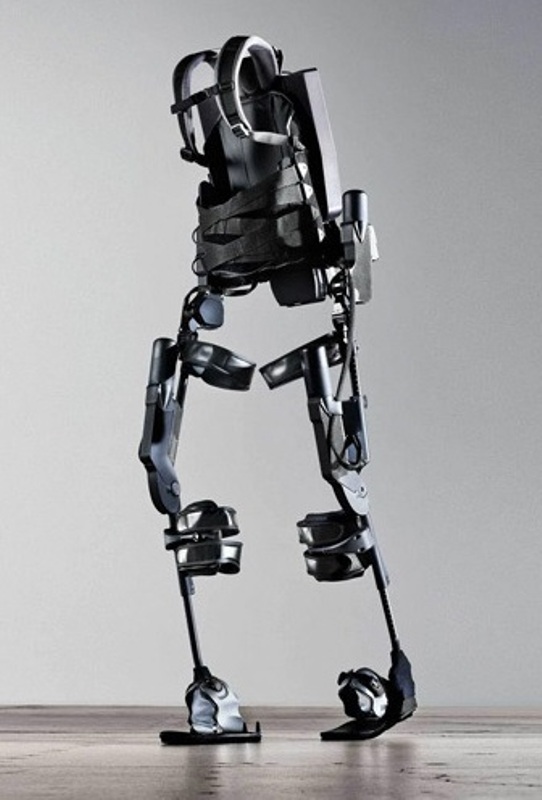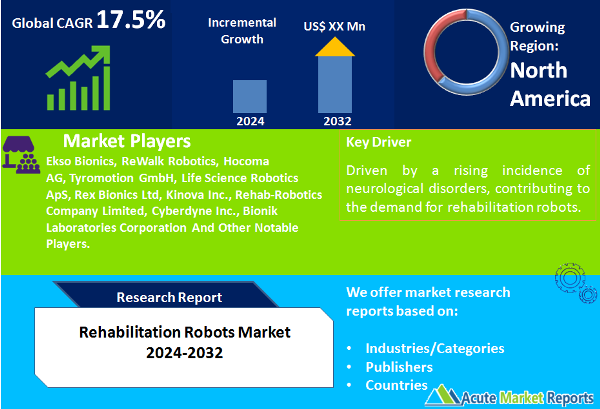
The rehabilitation robots market is characterized by transformative advancements and a growing emphasis on improving patient outcomes. The rehabilitation robots market is expected to grow at a CAGR of 17.5% during the forecast period of 2025 to 2033. The drivers, including technological advancements, the rising incidence of neurological disorders, and the increasing aging population, underline the market's transformative forces. The identified restraint related to high initial costs and limited accessibility signifies the economic challenges associated with widespread adoption. Market segmentation reveals the significance of therapy robots and the upper extremity in meeting healthcare needs, providing nuanced insights into provider and patient preferences. Geographic trends highlight the diversity in healthcare infrastructure and needs, while competitive trends underscore the importance of innovation, strategic partnerships, and regulatory compliance in maintaining a competitive edge.
Advancements in Robotics Technology: Revolutionizing Patient Rehabilitation
The rehabilitation robots market experiences significant growth propelled by continuous advancements in robotics technology. Evidence from technological breakthroughs in therapy robots and exoskeletons underscores the transformative impact on rehabilitation practices. The highest Compound Annual Growth Rate (CAGR) during the forecast period from 2025 to 2033 is anticipated in this segment, reflecting the industry's commitment to enhancing the efficacy of rehabilitation processes. As patients increasingly seek innovative and personalized rehabilitation solutions, technological progress becomes a pivotal driver shaping the market landscape.
Rising Incidence of Neurological Disorders: Addressing the Burden of Neurological Conditions
The market is driven by a rising incidence of neurological disorders, contributing to the demand for rehabilitation robots. Evidence from epidemiological studies and healthcare reports highlights the growing prevalence of conditions such as stroke and spinal cord injuries. The highest CAGR during the forecast period from 2025 to 2033 is expected in this segment, indicating the industry's responsiveness to the healthcare challenges posed by neurological disorders. As the burden of these conditions persists, the market for rehabilitation robots is poised for sustained growth, offering targeted solutions for patients undergoing neurological rehabilitation.

Increasing Aging Population: Catering to the Healthcare Needs of an Aging Demographic
Another significant driver is the increasing aging population, with rehabilitation robots playing a crucial role in addressing age-related health issues. Evidences from demographic trends and healthcare utilization patterns underscore the growing demand for rehabilitation solutions among the elderly. The highest CAGR during the forecast period from 2025 to 2033 is anticipated in this segment, reflecting the industry's recognition of the unique healthcare needs of an aging demographic. As the global population continues to age, the market for rehabilitation robots is expected to witness sustained expansion, providing essential support for elderly individuals in their rehabilitation journey.
High Initial Costs and Limited Accessibility: Navigating Economic Barriers to Adoption
A notable restraint in the rehabilitation robots market is associated with the high initial costs and limited accessibility of these advanced technologies. Evidence from economic analyses and healthcare affordability studies indicates the challenges in widespread adoption due to financial barriers. The highest CAGR during the forecast period from 2025 to 2033 is expected in this segment, signifying the industry's need to address cost-related concerns and enhance accessibility. As the market strives to overcome this restraint through innovative pricing models and collaborative initiatives, navigating economic barriers is crucial for fostering widespread adoption and market growth.
Market Segmentation by Type: Therapy Robots Dominates the Market
In 2024, the rehabilitation robots market showcased substantial revenue from therapy robots, with therapy robots leading in both revenue and CAGR. This reflects the industry's focus on developing advanced solutions for therapeutic interventions. The highest CAGR during the forecast period from 2025 to 2033 is expected in the exoskeleton category, showcasing the adaptability of devices to diverse rehabilitation needs. This segmentation provides insights into the evolving landscape of rehabilitation robots.
Market Segmentation by Extremity: Upper Body rehabilitation robots Dominate the Market
The rehabilitation robots market demonstrated significant revenue from upper body rehabilitation robots in 2024, with this category leading in both revenue and CAGR. This highlights the industry's focus on providing solutions for upper extremity rehabilitation. The highest CAGR during the forecast period from 2025 to 2033 is anticipated in the lower body rehabilitation robots category, indicating the growing demand for devices catering to lower extremity rehabilitation needs. This segmentation reveals the diverse preferences of healthcare providers and patients regarding rehabilitation robot applications.
North America Remains the Global Leader
North America dominated the rehabilitation robots market in 2024, contributing 45.0% of the total revenues. The regional increase in the incidence of spinal cord injuries is driving market expansion. The increasing prevalence of disabilities and the ageing population are two of the factors driving the demand for rehabilitation robotics. The 2020 CDC datasheet estimates that approximately one in every four Americans suffers from some form of disability. These statistics suggest that the implementation of rehabilitation machines could be advantageous for a greater portion of the population, thus stimulating economic development in the region. In addition, ongoing technological advancements and substantial government spending on healthcare research are driving market expansion in North America. Additionally, the expansion is fueled by the presence of private entities that provide funding for R&D to create technologically advanced products. Asia-Pacific is anticipated to experience the highest CAGR during the forecast period, at 25%. In the Asia-Pacific region, the increasing elderly population is the primary driver behind the implementation of rehabilitation robotics. The World Bank projects that by the conclusion of 2050, the geriatric population will have increased to around 1.3 billion individuals. Additionally, it is expected that expanding strategic initiatives, including mergers and acquisitions, the introduction of novel products, and collaborative endeavours, will contribute to the expansion of the regional industry. As a result, it is expected that these factors will stimulate expansion in the coming years.
Innovation in Robotic Design and Functionality to Decide on Market Shares of Key Competitors
The rehabilitation robots market's competitive landscape is marked by key players adopting strategies to enhance their market position. Major companies, including Ekso Bionics, ReWalk Robotics, Hocoma AG, Tyromotion GmbH, Life Science Robotics ApS, Rex Bionics Ltd, Kinova Inc., Rehab-Robotics Company Limited, Cyberdyne Inc., and Bionik Laboratories Corporation, have implemented diverse strategies to capitalize on market opportunities. Leading players in the rehabilitation robots market prioritize innovation in design and functionality as a key strategy. Evidences from product launches and industry exhibitions highlight the continuous efforts of companies like Ekso Bionics to introduce devices with enhanced features, catering to the evolving expectations of healthcare providers and patients. In 2024, these companies reported substantial revenues, with a projected increase during the forecast period from 2025 to 2033. The industry's commitment to innovation positions it at the forefront of meeting healthcare demands for sleek, user-friendly, and technologically advanced rehabilitation robots.
Historical & Forecast Period
This study report represents analysis of each segment from 2023 to 2033 considering 2024 as the base year. Compounded Annual Growth Rate (CAGR) for each of the respective segments estimated for the forecast period of 2025 to 2033.
The current report comprises of quantitative market estimations for each micro market for every geographical region and qualitative market analysis such as micro and macro environment analysis, market trends, competitive intelligence, segment analysis, porters five force model, top winning strategies, top investment markets, emerging trends and technological analysis, case studies, strategic conclusions and recommendations and other key market insights.
Research Methodology
The complete research study was conducted in three phases, namely: secondary research, primary research, and expert panel review. key data point that enables the estimation of Rehabilitation Robots market are as follows:
Market forecast was performed through proprietary software that analyzes various qualitative and quantitative factors. Growth rate and CAGR were estimated through intensive secondary and primary research. Data triangulation across various data points provides accuracy across various analyzed market segments in the report. Application of both top down and bottom-up approach for validation of market estimation assures logical, methodical and mathematical consistency of the quantitative data.
| ATTRIBUTE | DETAILS |
|---|---|
| Research Period | 2023-2033 |
| Base Year | 2024 |
| Forecast Period | 2025-2033 |
| Historical Year | 2023 |
| Unit | USD Million |
| Segmentation | |
Type
| |
Extremity
| |
End-Use
| |
|
Region Segment (2023-2033; US$ Million)
|
Key questions answered in this report